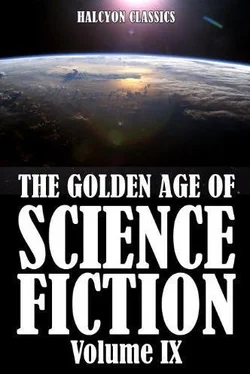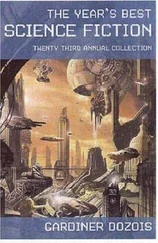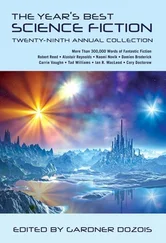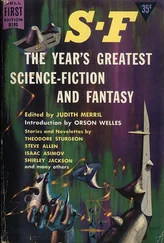We travelled a distance of some miles, and then the vessel was brought to a standstill.
What a splendid view we then had over the country all around us! the air being so thin and clear that there was very little dimming of the objects in the far distance. Across the country, in line after line, were the canals which we had been so anxious to see, extending as far as the eye could reach! With our glasses we made a detailed examination of several.
Our sensational newspapers have had paragraphs about Martian canals a hundred miles, or even hundreds of miles, wide! Scientific men have also similarly exaggerated, and made remarks about the absurdity of the supposition that such canals really existed.
There is very little excuse for such statements, because Professor Lowell has always been careful to point out that the lines represented broad bands of vegetation, and not the width of the canals.
Now the secret was out! What we actually saw was this: not a single wide canal but a series of comparatively narrow canals, running parallel to each other, with a very wide strip of vegetation between each. Usually the canals were linked together in pairs by smaller cross canals running diagonally from one canal to the other in alternate order. These were the irrigation trenches. Thus from one of a pair of canals an irrigation trench would branch out at an angle of about fifty degrees, and enter the second canal. Higher up, on the same side, another trench would run from the second canal at a similar angle, and enter the first canal, and so on—ad infinitum. In the case of single canals curved loops branched out and re-entered higher up, these loops being made on either side, and similar loops were made on the outsides of paired canals.
As a result of this arrangement it did not matter whether the water passed up the canal at one season of the year or down it at another season, it could always move straight ahead; the irrigation trenches were thus constantly flushed by one or other of the pairs, and there could be no stagnation anywhere. Merna also told us that some canals are provided with a network of trenches, whilst others are embanked so that the water can be let out through sluices when necessary, and thus flood the surrounding land. Thus every requirement can be met.
So far from being a hundred miles wide, it was exceptional for the canals to have a width of more than two hundred yards. Most of those we were looking at were only about sixty feet wide! and only the wider ones are used for navigation purposes. Merna explained why this was so, saying that as the main use of the canals was for irrigation purposes very wide ones were not required; for not only would they be wasteful, but as it was necessary to force the water along by artificial means, it could more conveniently be accomplished in the case of narrow canals, as the wider the canal the more difficult it became to force the water along.
We also observed many splendid wide motor-roads running between the single canals, as well as others running straight across the system, being carried over the canals by the most beautiful and fairy-like bridges that we had ever seen. They were all constructed of a metal identical with our “martalium,” which we had used in the construction of the Areonal; so that was undoubtedly another invention which we owed to Martian influences transmitted to us across space!
Nothing more beautiful or graceful than these bridges could be imagined, so light were they in construction, so elegant and varied in design, and every part shining in the sun like burnished silver; they looked like structures composed of rays of light rather than substantial metal! They were a perfect dream of beauty, and we stood a long time examining their elegant construction through our glasses.
“Well,” remarked John, “some of our millionaires would give half their fortunes to have such lovely bridges as these in their private parks!”
“Heh, mon!” replied M’Allister, “it’s very clear the Martians could teach our engineers something about bridge-building, if nothing else!”
“Wait and see our water-lifting and water-propelling machinery,” said Merna; “I think that will be something which will suit you as an engineer!”
I noticed that many of the lines were apparently groves of trees, and asked Merna whether they were canals or not.
“Yes,” he replied, “they are canals. You will understand that in the hotter parts of our world it is necessary to protect the water from too rapid evaporation, or else the canals would be almost run dry long before the need for their use ceased at the end of the season. Some are arched over entirely, but in most cases it is sufficient to plant trees along each side. Would you like to examine one?” he asked; “we can do so very soon, if you wish?”
I said I should be glad to do so, and our course was accordingly directed to one of the groves, which appeared to be about two miles distant. It, however, proved to be more than six miles away, for we had not yet become accustomed to the effect of the clear Martian air in making distant objects appear much closer than they really were. However, it did not take long for our air-ship to reach it; and we descended in the space between the canals and then walked over into the grove. When we turned into it, we were greatly surprised at the charming effect of the trees over the canal.
The trees were something like our willows, but taller than elms, and had a multitude of very long, thin, and supple branches, with very little bare trunk. They were planted rather close together, all along each side of the canal, with their trunks sloping slightly towards the water. The long branches thus met at the sides and high overhead, intertwining together, and forming a high leafy archway extending all along the canal in both directions as far as the eye could see. The thick, soft Martian grass along each side of the canal was like a velvet-pile carpet to walk upon; the sunlight filtering between the green leaves of the trees cast bright flecks of light on the clear shimmering water which ran beneath them; whilst water-fowl swimming here and there gave a bright touch of colour and the animation of life which so adds to the general charm of such scenery. Some of the water-fowl were very large birds, with brilliant coloured plumage.
“What a delightful place for a quiet walk on a hot day like this,” I exclaimed; “plenty of air and no excess of heat!”
“Yes,” Merna replied; “these embowered canals are very popular with the Martians, as they furnish such cool and pleasant walks in the summer time. I must also tell you,” he added, “that those water-fowl are looked after with extreme care, because most of our aquatic birds have become nearly extinct since our natural areas of water failed us, and unless they were preserved would die out entirely.
“You will understand that these canals are not liable to excessive evaporation; but, at the same time, it would not do to prevent evaporation altogether, because we should then fail to obtain a sufficient and fresh supply next spring.”
“I quite see that, Merna,” I said; “but one of our scientific men has said that it would be madness to construct canals on Mars, because the water would all quickly evaporate, especially in the warmer regions, and thus be wasted.”
“Well, as you see, sir, we manage to prevent evaporation to any extent we may desire,” replied Merna with a smile; “and even scientific men seem liable to omit some important matters from their theories and calculations.”
“How do you manage the irrigation?” I inquired; “the trenches seem rather wide apart to supply such a large area!”
“The upper layer of soil is very porous, and the water soaks along it,” he answered; adding that “where necessary it was assisted by porous pipes laid beneath the surface.
Читать дальше












